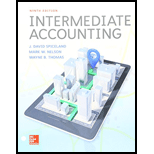
Concept explainers
Retail inventory method; conventional and LIFO
• LO9–3, LO9–4
Alquist Company uses the retail method to estimate its ending inventory. Selected information about its year 2018 operations is as follows:
- a. January 1, 2018, beginning inventory had a cost of $100,000 and a retail value of $150,000.
- b. Purchases during 2018 cost $1,387,500 with an original retail value of $2,000,000.
- c. Freight costs were $10,000 for incoming merchandise.
- d. Net additional markups were $300,000 and net markdowns were $150,000.
- e. Based on prior experience, shrinkage due to shoplifting was estimated to be $15,000 of retail value.
- f. Merchandise is sold to employees at a 20% of selling price discount. Employee sales are recorded in a separate account at the net selling price. The balance in this account at the end of 2018 is $250,000.
- g. Sales to customers totaled $1,750,000 for the year.
Required:
- 1. Estimate ending inventory and cost of goods sold using the conventional retail method.
- 2. Estimate ending inventory and cost of goods sold using the LIFO retail method. (Assume stable prices.)
1.
Retail inventory method: It takes into account all the retail amounts that is, the current selling prices. Under this method, the goods available for sale, at retail is deducted from the sales, at retail to determine the ending inventory, at retail.
Conventional Retail Method: Conventional retail method refers to the estimation of the lower of average cost or market by eliminating the markdowns from the calculation of the cost-to-retail percentage.
In this case, the cost-to-retail percentage will be determined by dividing the goods available for sale at cost by the goods available for at retail (excluding markdowns). Thus, the conventional retail method will always result in lower estimation of ending inventory when the markdowns exist.
To Calculate: The amount of ending inventory and cost of goods sold.
Explanation of Solution
The following table shows the ending inventory and cost of goods sold.
| Details | Cost ($) | Retail ($) |
| Beginning inventory | 100,000 | 150,000 |
| Add: Net purchase | 1,387,500 | 2,000,000 |
| Freight-in | 10,000 | |
| Net markups | 300,000 | |
| Less: Net markdowns | (150,000) | |
| Goods available for sale | 1,497,500 | 2,300,000 |
| Less: Normal Shrinkage | (15,000) | |
| Sales to customers | (1,750,000) | |
| Sales to employees | (250,000) | |
| Employee discounts | (62,500) | |
| Estimated ending inventory at retail | 222,500 | |
| Estimated ending inventory at cost | (135,992) (1) | |
| Estimated cost of goods sold | 1,361,508 |
Table (1)
Working Note:
Calculate cost-to-retail percentage.
Calculate the amount of estimated ending inventory at cost.
Therefore, the amount of ending inventory and cost of goods sold (conventional) at cost are $222,500 and $1,361,508.
2.
Last-In, First-Out (LIFO): In Last-in-First-Out method, the costs of last purchased items are sold first. The value of the closing stock consists the initial purchased items.
To Estimate: the amount of ending inventory and cost of goods sold (LIFO).
Explanation of Solution
Estimate the amount of ending inventory and cost of goods sold (LIFO).
| Details | Cost ($) | Retail ($) |
| Beginning inventory | 100,000 | 150,000 |
| Add: Net purchase | 1,387,500 | 2,000,000 |
| Freight-in | 10,000 | |
| Net markups | 300,000 | |
| Less: Net markdowns | (150,000) | |
Goods available for sale (excluding beginning inventory) |
1,397,500 | 2,150,000 |
Goods available for sale (including beginning inventory) |
1,497,500 | 2,300,000 |
| Less: Normal Shrinkage | (15,000) | |
| Sales to customers | (1,750,000) | |
| Sales to employees | (250,000) | |
| Employee discounts | (62,500) | |
| Estimated ending inventory at retail | 222,500 | |
| Estimated ending inventory at cost | (147,125) (3) | |
| Estimated cost of goods sold | 1,350,375 |
Table (2)
Working Notes:
Calculate cost-to-retail percentage:
Calculate the amount of estimated ending inventory at cost:
Therefore, the amount of ending inventory and cost of goods sold (LIFO) at cost are $222,500 and $1,350,375.
Want to see more full solutions like this?
Chapter 9 Solutions
GEN COMBO LOOSELEAF INTERMEDIATE ACCOUNTING; CONNECT ACCESS CARD
- The cost of goods sold by Yamamoto corporationarrow_forwardGeneral accountingarrow_forwardIn the first month of operations, the total of the debit entries to the cash account for Pulp Company amounted to $7,800, and the total of the credit entries to the cash account amounted to $5,250.What is the balance in the cash account at the end of the month?arrow_forward
- I need help finding the accurate solution to this financial accounting problem with valid procedures.arrow_forwardPlease explain the accurate process for solving this financial accounting question with proper principles.arrow_forwardI am trying to find the accurate solution to this general accounting problem with appropriate explanations.arrow_forward
 Cornerstones of Financial AccountingAccountingISBN:9781337690881Author:Jay Rich, Jeff JonesPublisher:Cengage Learning
Cornerstones of Financial AccountingAccountingISBN:9781337690881Author:Jay Rich, Jeff JonesPublisher:Cengage Learning Intermediate Accounting: Reporting And AnalysisAccountingISBN:9781337788281Author:James M. Wahlen, Jefferson P. Jones, Donald PagachPublisher:Cengage Learning
Intermediate Accounting: Reporting And AnalysisAccountingISBN:9781337788281Author:James M. Wahlen, Jefferson P. Jones, Donald PagachPublisher:Cengage Learning Financial Accounting: The Impact on Decision Make...AccountingISBN:9781305654174Author:Gary A. Porter, Curtis L. NortonPublisher:Cengage Learning
Financial Accounting: The Impact on Decision Make...AccountingISBN:9781305654174Author:Gary A. Porter, Curtis L. NortonPublisher:Cengage Learning Financial AccountingAccountingISBN:9781337272124Author:Carl Warren, James M. Reeve, Jonathan DuchacPublisher:Cengage Learning
Financial AccountingAccountingISBN:9781337272124Author:Carl Warren, James M. Reeve, Jonathan DuchacPublisher:Cengage Learning



